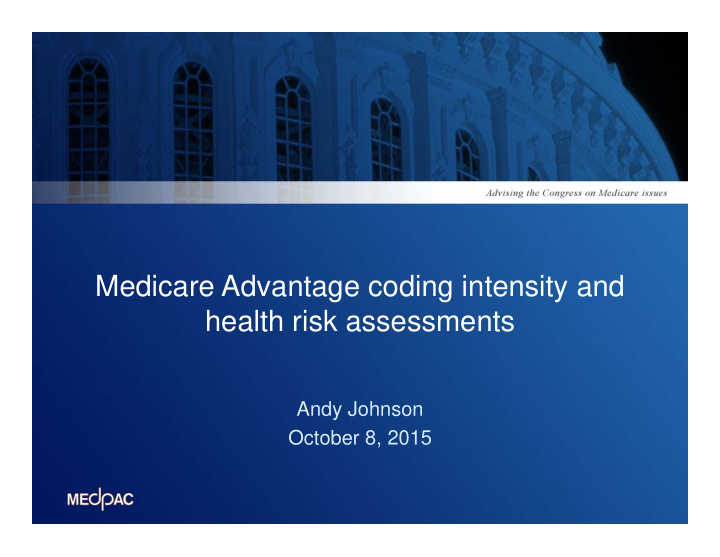



Medicare Advantage coding intensity and health risk assessments Andy Johnson October 8, 2015
Presentation outline Health risk assessments (HRAs) Medicare Advantage (MA) risk adjustment Impact of HRAs on MA plan payments Diagnostic coding differences Alternative policies for coding intensity 2
Health risk assessments Preventative care tool to identify health risks and presence of disease or disability Framework for providing counseling, follow-up referrals, and patient engagement in health decision-making Part of Medicare’s annual wellness visit (AWV), available to all Medicare beneficiaries 3
Health risk assessments in MA Administered in enrollee’s home: Self-reported medical history, blood or urine tests, review medications, assess home risks Initiated by MA organization: Third-party vendors or MA organizations recruit MA enrollees for a home visit Increasing number of home visits annually Expansion of related entities 4
MA risk adjustment CMS pays MA plans a capitated rate for each enrollee Risk-adjusted using the CMS-hierarchical condition category (HCC) model Model includes demographic information and groups of diagnoses, called HCCs Components associated with an expected cost Payment rate is the sum of expected spending for relevant model components 5
MA risk adjusted payment Example payment for 2013: Payment for an 84 year-old male with congestive heart failure: 84 year-old male $4,727 Congestive Heart Failure $3,116 Payment to MA organization: $7,843 Payment with addition of polyneuropathy: Polyneuropathy $2,890 Payment to MA organization: $10,733 Source: CMS Advance Notice for 2013 payment. 6
Increase in annual payment, by HCC Source: CMS Advance Notice for 2013 payment. 7
HRA use in MA Analyzed 2012 MA encounter data 1) HRAs (AWV or HRA admin HCPCS code) 2) HRAs plus home E&M visits Focus on HCCs identified only through health risk assessment Not identified through other encounter used for MA risk adjustment 8
HRA use in MA, 2012 Health Risk HRAs & Assessments Home E&M visits Number of encounters 1.4 million 2.3 million Number of unique MA 1.2 million 1.7 million enrollees New HCCs identified 196,625 749,159 Increase in payment to $602 million $2.3 billion MA organizations, 2013 Note: HCC numbers and payments to MA organizations do not reflect the imposition of hierarchies, which affect certain HCCs. Source: MedPAC analysis of 2012 MA encounter data. DATA PRELIMINARY AND SUBJECT TO CHANGE . 9
Payment per enrollee for HRA or home E&M-only HCCs, by contract Source: MedPAC analysis of 2012 MA encounter data. DATA PRELIMINARY AND SUBJECT TO CHANGE . 10
Concerns about using HRA diagnoses in MA payment Medicare payments to MA plans aim to cover the plan’s cost in treating an enrollee’s conditions The circumstances of collecting diagnostic information in the home raises questions about some HCCs Concerns are especially heightened when there is no corroborating medical encounter (e.g., office visit, procedure, treatment, etc.) 11
Focus groups Nearly all MA enrollees received a home visit offer, some received gift cards Half accepted, found the visit pleasant Half declined, annoyed by persistent calls Primary care physicians were aware of home visits Did not find home visit reports valuable Some spent time ruling out conditions misdiagnosed during a home visit 12
Diagnostic coding differences Greater incentive to identify diagnoses in MA compared to Medicare FFS increases MA risk scores We estimated that MA risk scores were about 8 percent higher than Medicare FFS in 2013 Kronick and Welch estimate: 9 percent higher The impact of coding differences varies across MA contracts and plan type 13
CMS’s approach to addressing coding intensity For 2016 payment, CMS will: Reduce all MA payments by 5.41 percent Remove diagnoses with different coding rates Flag home HRA diagnoses & track care Coding intensity impact estimate for 2016: 8 or 9 percent (estimated for 2013 risk scores) plus 3 years of accumulated differences Greater than CMS’s combined adjustments 14
Option #1 to address coding intensity HRAs can be used as a prevention and care-planning tool Exclude diagnoses from HRAs from MA risk adjustment HRA diagnoses resulting in follow-up care will be identified during subsequent encounter Exclude HRA diagnoses from FFS and MA Equitable approach across MA contracts 15
Option #2 to address coding intensity Use 2 years of Medicare FFS and MA diagnostic data for risk adjustment Most HCCs in the model identify chronic conditions that do not change status frequently Reduces the impact of coding differences between FFS and MA 16
Address remaining coding intensity Options 1 and 2 can be implemented simultaneously Options 1 and 2 may not address full impact of coding intensity differences Continue to adjust by a single factor More equitable across MA contracts Improved data quality and consistency 17
Commission discussion Questions on findings Discussion about options for addressing differences in diagnostic coding 18
Recommend
More recommend